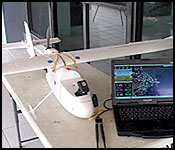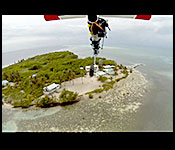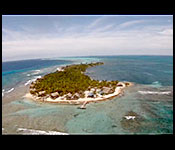

 This year, the Fisheries Department has been making news with some high profile busts of illegal product, form lobster and conch to sea cucumber. Policing the country's coastline, however, is not an easy task, and it is also very expensive because of fuel costs.
This year, the Fisheries Department has been making news with some high profile busts of illegal product, form lobster and conch to sea cucumber. Policing the country's coastline, however, is not an easy task, and it is also very expensive because of fuel costs.
In their effort to become more efficient, and the Department is now employing high-tech aerial drones to help with maritime enforcement. The media was invited to the unveiling of these state of the art aircraft which will now be their eyes over the water.
Daniel Ortiz reports:
Daniel Ortiz reporting
It might look like just a remote controlled plane, but this sophisticated new toy for the Fisheries Department is a drone.
It is supposed to be the Department's new means of policing Belize's waters in trying to detect illicit activities.
 Beverly Wade - Fisheries Administrator
Beverly Wade - Fisheries Administrator
"Over the years we've enjoyed and benefitted from a very strategic partnership with the wildlife conservation society and they have work with the fisheries department to promote sustainable fisheries in Belize. One of the things that we have grappled with over time is the high cost of enforcement activities and we have a very immense coastline and we have been looking at new ways, new innovative approaches through enforcement in Belize."
And that's where the drone comes in. Each is controlled by a computer, which maps its coordinates and sets out its flight plan. Each drone is then able to take a carefully chosen path. It provides surveillance by capturing video footage taken along its flight, a very cost effective and efficient means of policing presence for the fisheries Officers.
 Joseph Douglas - Representative, Conservation Drones.Org
Joseph Douglas - Representative, Conservation Drones.Org
"It is powered by lithium batteries and its cruise speed is about 14 meters per second. It can travel faster but we prefer slower speeds so we can capture good video. First of all its 1080p action cameras, it takes great videos and there are 2 cameras on the plane; one facing about a 45 degree on the nose and one facing directly down. As far as how sturdy of how protective they are, they are in a case, but I imagine touch crashes could result in damage to them."
Daniel Ortiz
"In terms of video that is captured, is it fed directly back to the computer or is it stored on a device?"
Joseph Douglas
"The camera stores the video on a SD card in the camera itself. The main computer which allows it to go automatic way points and that's accompanied with a GPS, so you can actually put in whatever coordinate you want and the plane will fly to it. You put in the auto and from there you just fit a motor that was efficient as well as powerful enough to fly at the speeds we want and keep the plane stable. What we can do with it is setup a bunch of way points or decides a certain area that we want to capture and video. If you decide a certain area then it will automatically generate the way points that it should fly to, to capture that area. The goal is to find the area you want, send it up and then it's going to capture all the video you need and then it's going to come right back to you."
Beverly Wade
"Basically it's like us having a camera in the air, eyes in the air, giving us a view of activities that are happening out there and allowing us to be a little bit more strategic with our response. Rather than launching patrols to cover an entire area, it allowed us to see what is happening out there and have more directed responses and at the same time it allows us to now be more efficient without resources that is allocated to us through our budgetary processes."
The cost of each drone, plus the cost to train Fisheries personnel to operate them, is $6,000 Belize dollars. These drones have been made possible through the collaboration of the World Conservation Society and Fisheries.



